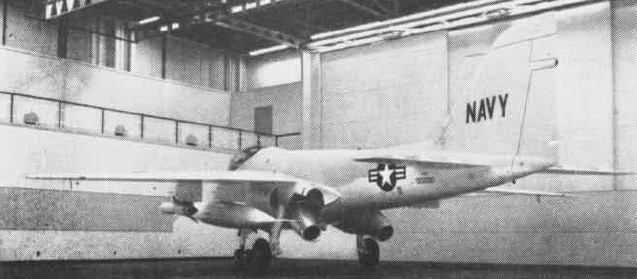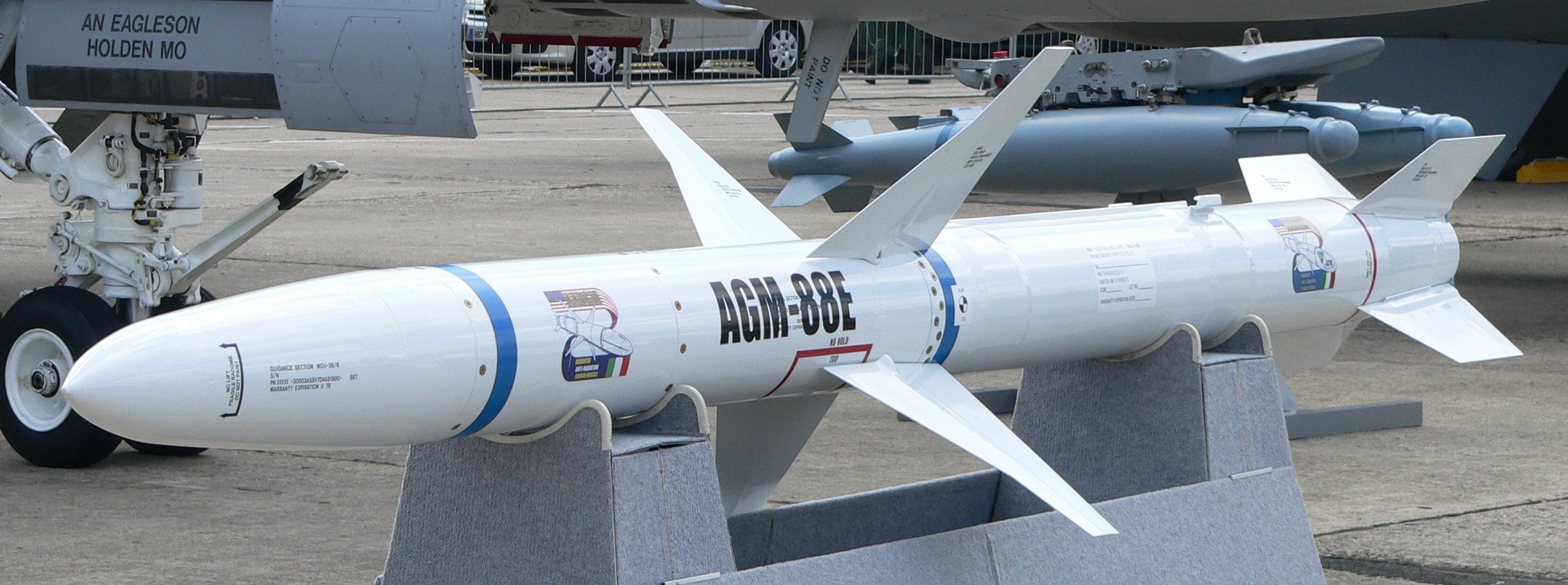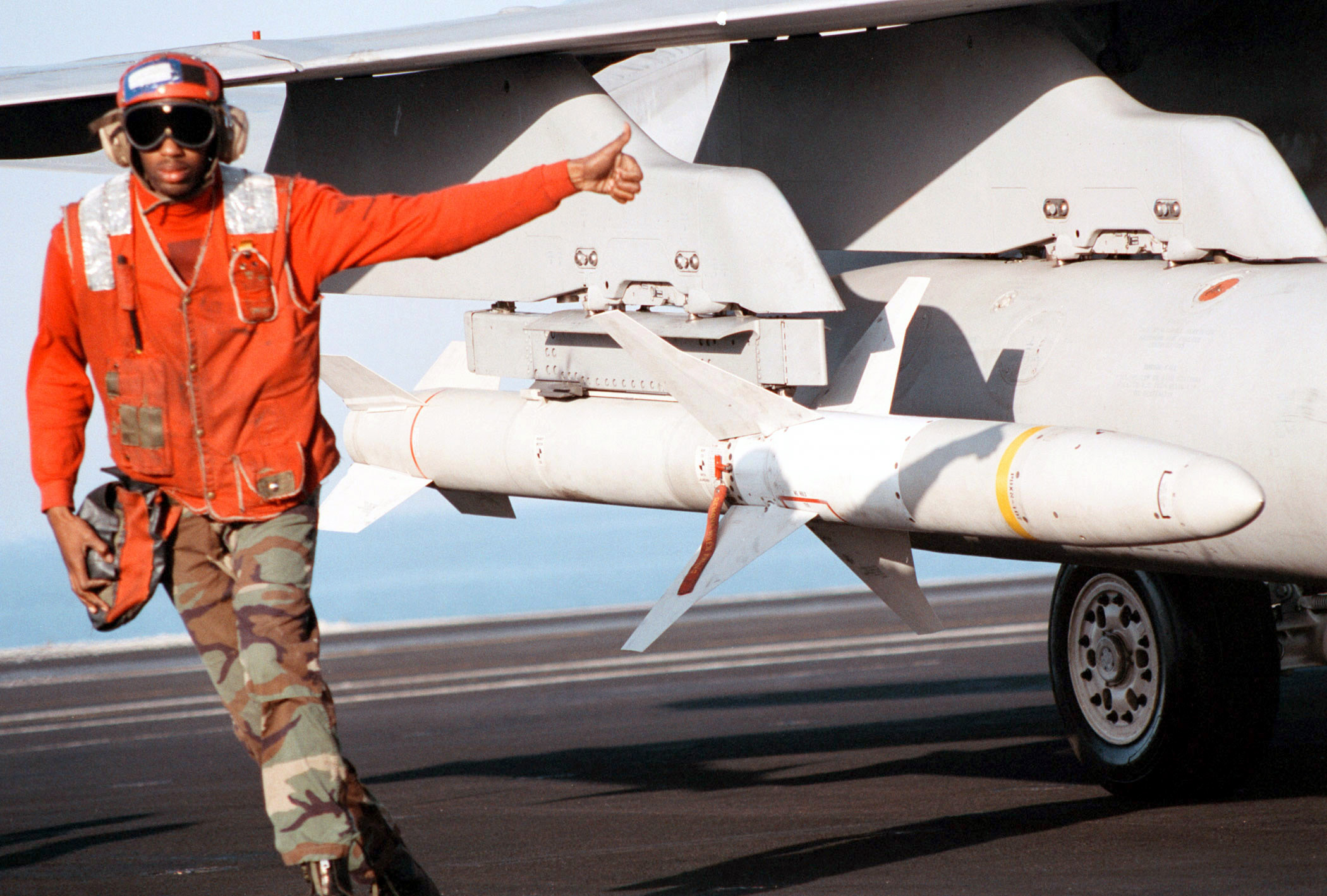|
AGM-45
AGM-45 Shrike is an American anti-radiation missile designed to home in on hostile anti-aircraft radar. The Shrike was developed by the Naval Weapons Center at China Lake in 1963 by mating a seeker head to the rocket body of an AIM-7 Sparrow. It was phased out by U.S. in 1992 and at an unknown time by the Israeli Air Force (the only other major user), and has been superseded by the AGM-88 HARM missile. The Israel Defense Forces developed a version of the Shrike that could be ground-launched with a booster rocket, and mounted it on an M4 Sherman chassis as the Kilshon (Hebrew for ''Trident''). History The Shrike was first employed during the Vietnam War by the Navy in 1965 using A-4 aircraft. The Air Force adopted the weapon the following year using F-105F and G Thunderchief Wild Weasel SEAD aircraft, and later the F-4 Phantom II in the same role. The range was nominally shorter than the SA-2 Guideline missiles that the system was used against, although it was a great ... [...More Info...] [...Related Items...] OR: [Wikipedia] [Google] [Baidu] |
A-6 Intruder
The Grumman A-6 Intruder is an American twinjet all-weather attack aircraft developed and manufactured by American aircraft company Grumman Aerospace and operated by the U.S. Navy and U.S. Marine Corps. It was designed in response to a 1957 requirement issued by the Bureau of Aeronautics for an all-weather attack aircraft for Navy long-range interdiction missions and with short takeoff and landing (STOL) capability for Marine close air support. It was to replace the piston-engined Douglas A-1 Skyraider. The requirement allowed one or two engines, either turbojet or turboprop. The winning proposal from Grumman used two Pratt & Whitney J52 turbojet engines. The Intruder was the first Navy aircraft with an integrated airframe and weapons system. Operated by a crew of two in a side-by-side seating configuration, the workload was divided between the pilot and weapons officer (bombardier/navigator (BN)). In addition to conventional munitions, it could also carry nuclear weapons, ... [...More Info...] [...Related Items...] OR: [Wikipedia] [Google] [Baidu] |
F-105 Thunderchief
The Republic F-105 Thunderchief is an American supersonic fighter-bomber that served with the United States Air Force from 1958 to 1984. Capable of Mach 2, it conducted the majority of strike bombing missions during the early years of the Vietnam War; it was the only American aircraft to have been removed from combat due to high loss rates. It was originally designed as a single-seat, nuclear-attack aircraft; a two-seat Wild Weasel version was later developed for the specialized Suppression of Enemy Air Defenses (SEAD) role against surface-to-air missile sites. The F-105 was commonly known as the "Thud" by its crews. As a follow-on to the Mach 1 capable North American F-100 Super Sabre, the F-105 was also armed with missiles and a rotary cannon; however, its design was tailored to high-speed low-altitude penetration carrying a single nuclear weapon internally. First flown in 1955, the Thunderchief entered service in 1958. The single-engine F-105 could deliver a bomb load great ... [...More Info...] [...Related Items...] OR: [Wikipedia] [Google] [Baidu] |
AGM-88 HARM
The AGM-88 HARM (High-speed Anti-Radiation Missile) is a tactical, air-to-surface anti-radiation missile designed to home in on electronic transmissions coming from surface-to-air radar systems. It was originally developed by Texas Instruments as a replacement for the AGM-45 Shrike and AGM-78 Standard ARM system. Production was later taken over by Raytheon Corporation when it purchased the defense production business of Texas Instruments. Description The AGM-88 can detect, attack and destroy a radar antenna or transmitter with minimal aircrew input. The proportional guidance system that homes in on enemy radar emissions has a fixed antenna and seeker head in the missile's nose. A smokeless, solid-propellant, booster-sustainer rocket motor propels the missile at speeds over Mach 2.0. The HARM was a missile program led by the U.S. Navy, and it was first carried by the A-6E, A-7, and F/A-18A/B aircraft, and then it equipped the EA-6B and EA-18G dedicated electronic attack aircraft ... [...More Info...] [...Related Items...] OR: [Wikipedia] [Google] [Baidu] |
Wild Weasel
Wild Weasel is a code name given by the United States Air Force (USAF) to an aircraft of any type equipped with anti-radiation missiles and tasked with the suppression of enemy air defenses (SEAD): destroying the radar and surface-to-air missile (SAM) installations of enemy air defense systems.Hewitt, W.A''Planting the seeds of SEAD: The Wild Weasel in Vietnam'' School of Advanced Airpower Studies, Air University, Maxwell Air Force Base, Alabama, PhD Thesis. May 1992. Accessed 5 October 2009. The task of a Wild Weasel aircraft is to bait enemy anti-aircraft defenses into targeting it with their radars, whereupon the radar waves are traced back to their source, allowing the Weasel or its teammates to precisely target it for destruction. The Wild Weasel concept was developed by the USAF in 1965 during the Vietnam War after the introduction of Soviet SAMs and their downing of American strike aircraft participating in Operation Rolling Thunder in the skies over North Vietnam. The ... [...More Info...] [...Related Items...] OR: [Wikipedia] [Google] [Baidu] |
Anti-radiation Missile
An anti-radiation missile (ARM) is a missile designed to detect and home in on an enemy radio emission source. Typically, these are designed for use against an enemy radar, although jammers and even radios used for communications can also be targeted in this manner. The earliest known anti-radiation weapon is a variant of the Blohm & Voss BV 246 radar guided bomb. Air-to-surface Most ARM designs to date have been intended for use against ground-based radars. Commonly carried by specialist aircraft in the Suppression of Enemy Air Defenses (SEAD) role (known to United States Air Force as "Wild Weasels"), the primary purpose of this type of missile is to degrade enemy air defenses in the first period of a conflict in order to increase the chance of survival for the following waves of strike aircraft. They can also be used to quickly shut down unexpected surface-to-air missile (SAM) sites during an air raid. Often, SEAD escort aircraft also carry cluster bombs, which can be u ... [...More Info...] [...Related Items...] OR: [Wikipedia] [Google] [Baidu] |
Operation El Dorado Canyon
The 1986 United States bombing of Libya, code-named Operation El Dorado Canyon, consisted of air strikes by the United States against Libya on Tuesday 15 April 1986. The attack was carried out by the U.S. Air Force (USAF), U.S. Navy and U.S. Marine Corps via air strikes, in retaliation for the West Berlin discotheque bombing ten days earlier, which U.S. President Ronald Reagan blamed on Libyan leader Muammar Gaddafi. There were 40 reported Libyan casualties, and one U.S. plane was shot down. One of the claimed Libyan deaths was of a baby girl, reported to be Gaddafi's daughter, Hana Gaddafi. However, there are doubts as to whether she was really killed, or whether she really even existed. Origins Libya represented a high priority for President Ronald Reagan shortly after his 1981 inauguration. Libyan leader Muammar Gaddafi was firmly anti-Israel and had supported violent organizations in the Palestinian territories and Syria. There were reports that Libya was attempting to ... [...More Info...] [...Related Items...] OR: [Wikipedia] [Google] [Baidu] |
AGM-78 Standard ARM
The AGM-78 Standard ARM was an anti-radiation missile developed by General Dynamics, United States. It was built on the airframe of the RIM-66 Standard surface-to-air missile, resulting in a very large weapon with considerable range, allowing it to attack targets as much as away. Overview Originally developed for the US Navy during the late 1960s, the AGM-78 was created in large part because of the limitations of the AGM-45 Shrike, which suffered from a small warhead, limited range and a poor guidance system. General Dynamics was asked to create an air-launched ARM by modifying the RIM-66 SM-1 surface-to-air missile. This use of an "off the shelf" design greatly reduced development costs, and trials of the new weapon began in 1967 after only a year of development. The first operational missiles were issued in early 1968. The AGM-78 was nicknamed the "Starm", an abbreviation of Standard ARM. The first version of the missile, the A1 Mod 0, was little more than an air-launched RIM ... [...More Info...] [...Related Items...] OR: [Wikipedia] [Google] [Baidu] |
SA-2 Guideline
The S-75 (Russian: С-75; NATO reporting name SA-2 Guideline) is a Soviet-designed, high-altitude air defence system, built around a surface-to-air missile with command guidance. Following its first deployment in 1957 it became one of the most widely deployed air defence systems in history. It scored the first destruction of an enemy aircraft by a surface-to-air missile, with the shooting down of a Taiwanese Martin RB-57D Canberra over China on 7 October 1959 that was hit by a salvo of three V-750 (1D) missiles at an altitude of 20 km (65,600 ft). This success was credited to Chinese fighter aircraft at the time to keep the S-75 program secret. This system first gained international fame when an S-75 battery, using the newer, longer-range, higher-altitude V-750VN (13D) missile was deployed in the 1960 U-2 incident, when it shot down the U-2 of Francis Gary Powers overflying the Soviet Union on May 1, 1960. The system was also deployed in Cuba during the Cuban Missile ... [...More Info...] [...Related Items...] OR: [Wikipedia] [Google] [Baidu] |
Air-to-surface
An air-to-surface missile (ASM) or air-to-ground missile (AGM) is a missile designed to be launched from military aircraft at targets on land or sea. There are also unpowered guided glide bombs not considered missiles. The two most common propulsion systems for air-to-surface missiles are rocket motors, usually with shorter range, and slower, longer-range jet engines. Some Soviet-designed air-to-surface missiles are powered by ramjets, giving them both long range and high speed. Guidance for air-to-surface missiles is typically via laser guidance, infrared guidance, optical guidance or via satellite guidance signals. The type of guidance depends on the type of target. Ships, for example, may be detected via passive radar or active radar homing, less effective against multiple, small, fast-moving land targets. There is some cross-over between air-to-surface missiles and surface-to-surface missiles. For example, there was an air-launched version of the Tomahawk missile, sup ... [...More Info...] [...Related Items...] OR: [Wikipedia] [Google] [Baidu] |
Naval Air Weapons Station China Lake
Naval Air Weapons Station (NAWS) China Lake is a large military installation in California that supports the research, testing and evaluation programs of the United States Navy. It is part of Navy Region Southwest under Commander, Navy Installations Command, and was originally known as Naval Ordnance Test Station (NOTS). The installation is located in the Western Mojave Desert region of California, approximately north of Los Angeles. Occupying land in three counties – Kern, San Bernardino, and Inyo – the installation's closest neighbors are the city of Ridgecrest and the communities of Inyokern, Trona, and Darwin. China Lake is the United States Navy's largest single landholding, representing 85% of the Navy's land for weapons and armaments research, development, acquisition, testing and evaluation (RDAT&E) use and 38% of the Navy's land holdings worldwide. In total, its two ranges and main site cover more than , an area larger than the state of Rhode Island. As of 2010, ... [...More Info...] [...Related Items...] OR: [Wikipedia] [Google] [Baidu] |
Avro Vulcan
The Avro Vulcan (later Hawker Siddeley Vulcan from July 1963) is a jet-powered, tailless, delta-wing, high-altitude, strategic bomber, which was operated by the Royal Air Force (RAF) from 1956 until 1984. Aircraft manufacturer A.V. Roe and Company ( Avro) designed the Vulcan in response to Specification B.35/46. Of the three V bombers produced, the Vulcan was considered the most technically advanced, hence the riskiest option. Several reduced-scale aircraft, designated Avro 707s, were produced to test and refine the delta-wing design principles. The Vulcan B.1 was first delivered to the RAF in 1956; deliveries of the improved Vulcan B.2 started in 1960. The B.2 featured more powerful engines, a larger wing, an improved electrical system, and electronic countermeasures, and many were modified to accept the Blue Steel missile. As a part of the V-force, the Vulcan was the backbone of the United Kingdom's airborne nuclear deterrent during much of the Cold War. Although the ... [...More Info...] [...Related Items...] OR: [Wikipedia] [Google] [Baidu] |
F-4 Phantom II
The McDonnell Douglas F-4 Phantom II is an American tandem two-seat, twin-engine, all-weather, long-range supersonic jet interceptor and fighter-bomber originally developed by McDonnell Aircraft for the United States Navy.Swanborough and Bowers 1976, p. 301. Proving highly adaptable, it entered service with the Navy in 1961 before it was adopted by the United States Marine Corps and the United States Air Force, and by the mid-1960s it had become a major part of their air arms. Phantom production ran from 1958 to 1981 with a total of 5,195 aircraft built, making it the most produced American supersonic military aircraft in history, and cementing its position as an iconic combat aircraft of the Cold War."F-4 Phantoms Phabulous 40th" Boeing. Retrieved : 27 November 2012. [...More Info...] [...Related Items...] OR: [Wikipedia] [Google] [Baidu] |










